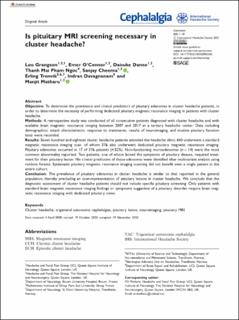| dc.description.abstract | Objective
To determine the prevalence and clinical predictors of pituitary adenomas in cluster headache patients, in order to determine the necessity of performing dedicated pituitary magnetic resonance imaging in patients with cluster headache.
Methods
A retrospective study was conducted of all consecutive patients diagnosed with cluster headache and with available brain magnetic resonance imaging between 2007 and 2017 in a tertiary headache center. Data including demographics, attack characteristics, response to treatments, results of neuroimaging, and routine pituitary function tests were recorded.
Results
Seven hundred and eighteen cluster headache patients attended the headache clinic; 643 underwent a standard magnetic resonance imaging scan, of whom 376 also underwent dedicated pituitary magnetic resonance imaging. Pituitary adenomas occurred in 17 of 376 patients (4.52%). Non-functioning microadenomas (n = 14) were the most common abnormality reported. Two patients, one of whom lacked the symptoms of pituitary disease, required treatment for their pituitary lesion. No clinical predictors of those adenomas were identified after multivariate analysis using random forests. Systematic pituitary magnetic resonance imaging scanning did not benefit even a single patient in the entire cohort.
Conclusion
The prevalence of pituitary adenomas in cluster headache is similar to that reported in the general population, thereby precluding an over-representation of pituitary lesions in cluster headache. We conclude that the diagnostic assessment of cluster headache patients should not include specific pituitary screening. Only patients with standard brain magnetic resonance imaging findings or symptoms suggestive of a pituitary disorder require brain magnetic resonance imaging with dedicated pituitary views. | en_US |

